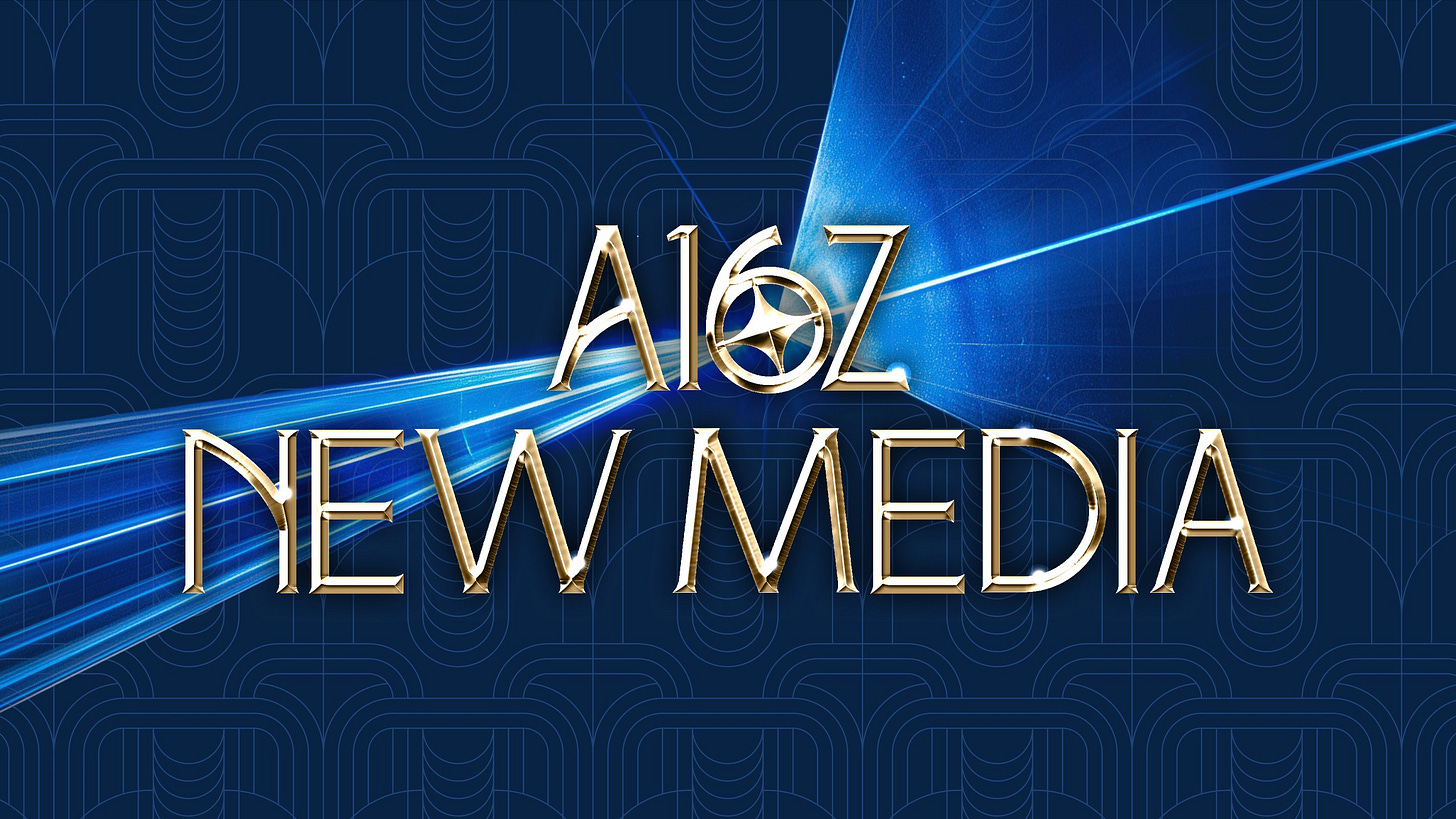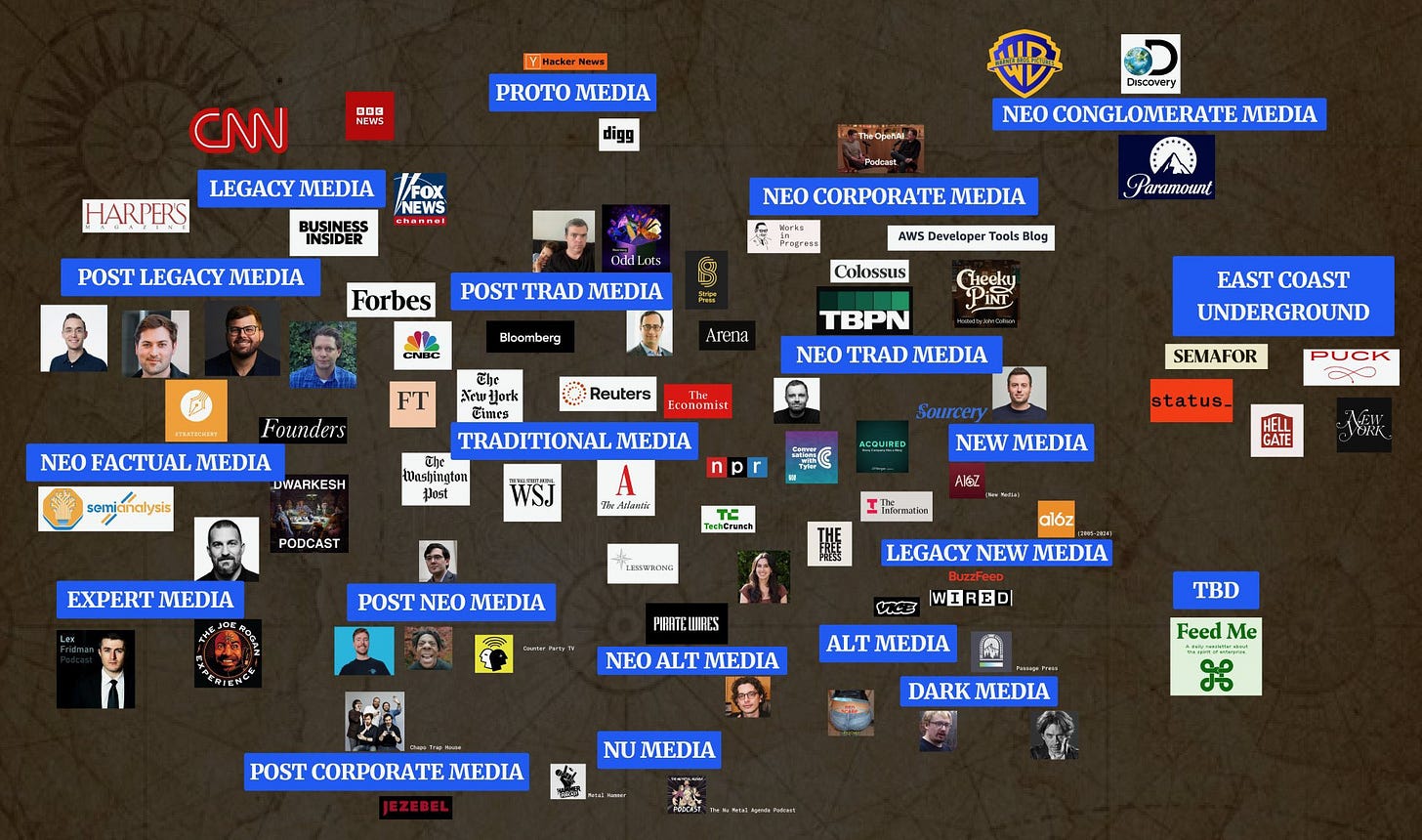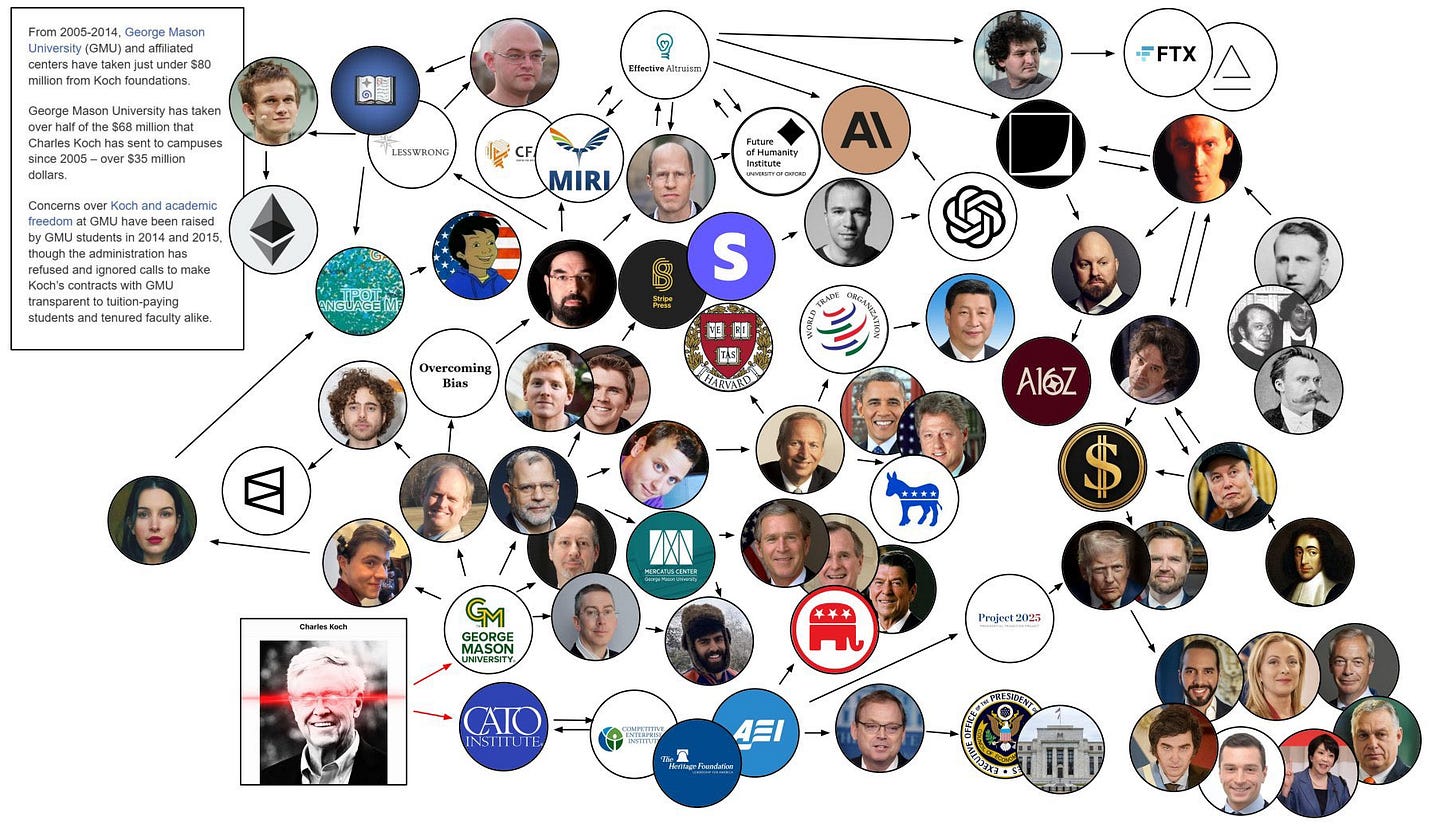is new media a term we should still be using?
things right now 54—week of 11.10.25
a16z New Media Fellowship or a challenge to New York
New Media Map or TBPN’s media categories
Last week a16z announced its New Media Fellowship.
Spearheaded by a16z General Partner Erik Torenberg and TBPN alum Brent Liang, the announcement was accompanied by a post from Liang the following day:
top 2 “market maps” of the year
new meta
I’ve been stuck on the first map, sourced from TBPN, Liang’s former employer. It does feel like it’s pointing to some 'there there'. But the ‘there there’ is foggy.
Maps typically need to pick one parameter and stick with it. Are they thorough in their round-up of the players? Or are they thorough in their choice of categories? Categorical maps are not exhaustive. Instead, they select case studies best exemplifying each category.
Let’s focus on the first map, as the second has less to do with new media and more to do with the political funding of certain media outlets.
the categories
Legacy Media: CNN, BBC, Fox News, Harper’s Magazine, and Business Insider; a mix of digital, print, and broadcast media. Harper’s stands out as the sole print-only media outlet. Though I suppose it’s supposed to underscore that legacy means old. (It’s the longest-running, continuously published magazine in the United States.)
Post Legacy Media: Ashlee Vance, author of the 2015 Elon Musk biography, the tech journalist Alex Konrad from Upstarts Media, a Substack focusing on start-ups, tech reporter Eric Newcomer, another Substacker, and Alex Heath, yet another tech-focused Substacker, the business podcast Stratechery, and the entrepreneur podcast Founders; Post Legacy Media is the crop of tech-friendly journalists and their independent media channels.
Neo Factual Media: Semianalysis, Andew Huberman, and Dwarkesh Podcast; a datacenter-powered research company, a health influencer, and a research-focused technology podcast. Huberman famously is a Stanford neuroscientist. This category contains media backed by scientific research, deep dives and more rigorous quantitative approaches.
Expert Media: The Joe Rogan Experience and The Lex Fridman Podcast; both interview various domain-specific experts. Although in Rogan’s case, this includes eccentrics i.e. people accused of being various flavors of conspiracy theorists.
Post Neo Media: Martin Shkreli, Mr. Beast, IShowSpeed, and Counterparty; YouTube-focused, internet personality-inflected entertainment. I’m not so sure what the name means.
Post Corporate Media: Chapo Trap House and Jezebel; the Dirtbag Left and millennial feminists. Again, not so sure about the category title. The Chapo crew mostly wrote for small left-leaning publications before starting the podcast and Jezebel was a Gawker Media-owned outlet. More than anything, both were powered by early Twitter personalities. Proto-woke Twitter in the case of Jezebel and "Weird Twitter" in the case of Chapo.
Nu Media: the podcasts Metal Hammer and The Nu Metal Agenda. I get the joke. Perhaps I am taking this diagram too seriously.
Traditional Media: The New York Times, The Washington Post, The Financial Times, The Wall Street Journal, The Atlantic, NPR, The Economist, and Reuters; print publications, including newspapers and magazines, and America’s public broadcasting network. All are very storied and prestigious. It’s curious Harper’s is not included here.
Post Trad Media: Bloomberg, Forbes, CNBC, Stripe Press, Arena, and Odd Lots. I’m not familiar with the two media personalities included and Google Lens was no help. We have business-focused media—print, digital, broadcast, and podcast—as well as the publishing arm of the payments processor Stripe. What distinguishes Post Trad Media from Traditional Media seems to be their friendliness towards the business community.
Proto Media: Hacker News and Digg; both are news aggregators.
Alt Media: Vice and Wired; print and digital outlets covering subculture and technology, respectively. Wired was very much a part of the original Bay Area tech subculture that preceded mass adoption of the internet. Vice exported Williamsburg hipsterdom to the masses.
Neo Alt Media: Pirate Wires, a Substack-powered media outlet founded by Founders Fund VP Mike Solana, the podcaster Adam Friedland, possibly tech and culture journalist Taylor Lorenz, the rationalist blog Less Wrong, and the media outlet TechCrunch. The last three seem to be between Traditional Media and Neo Alt Media. Pirate Wires, Lorenz and Friedland all cover—and in the case of internet personalities Friedland and Lorenz—are internet culture. Less Wrong popularized the rationalist community and TechCrunch was very much the go-to media source of the second tech boom in the early 2010s.
Dark Media: Red Scare, Curtis Yarvin, Sam Hyde, and the publishing house, Passage Press; post-cancelled media projects predominantly based in New York and Los Angeles. They’re decidedly subcultural, even with Mr. Yarvin’s newfound infamy.
Legacy New Media: Bari Weiss’ Substack-powered The Free Press, The Information, Buzzfeed and a16z (2005—2024). The Free Press and The Information are two of the most commercially successful new media channels. While The Free Press features broad coverage of national politics and culture, The Information, like many of the other outlets featured, is focused on business and technology. Buzzfeed pioneered viral news. The a16z shout-out seems to signal the fund is shifting its focus to new media, full stop.
New Media: Jack Altman, venture capitalist and host of the podcast Uncapped, Conversations with Tyler, business podcasts Acquired and Sourcery, and a16z (new media). All besides the libertarian blogger Tyler Cowan are business-focused media. In the case of a16z and Uncapped, the initiatives are backed by venture capital firms, while Acquired is hosted by former venture capitalists.
Neo Trad Media: Cheeky Pint and TBPN (Technology Business Programming Network). I’m not familiar with the media personality in black and white. Again, Google Lens was no help. TBPN broadcasts in the style of CNN or Fox News.
Neo Corporate Media: AWS Developer Tools Blog, The OpenAI Podcast, the business-focused private podcast Colossus, and Stripe’s Works in Progress, a digital magazine. Three of the Neo Corporate Media examples are owned by Amazon, OpenAI, and Stripe, respectively.
Neo Conglomerate Media: Paramount, Warner Brothers, and Discovery; Neo Conglomerate Media outlets are post-merger Hollywood entertainment companies.
East Coast Underground: Semafor, Status_, Hell Gate, Puck, and New York Magazine; a transparent journalism initiative founded by former New York Times correspondent Ben Smith, a media outlet about media, a work-owned media outlet, more media about media (plus power structures) and a New York-centric culture and trends publication. I’m a little skeptical New York Magazine is underground, but broadly the other three are left-leaning critiques of the New York media establishment.
TBD: Feed Me, Emily Sundberg’s wildly popular Substack newsletter. It bills itself as business-focused but has a much broader cultural lens.
Once again, I am skeptical of these categories. They’re medium agnostic. Internet personalities are mixed with Substack newsletters, cable news networks, newspapers, podcasts, and blogs. There is ambivalence about ownership. There’s one worker-owned collective and many venture capital owned outlets. Still others are publicly traded corporations.
Overall, the distinction between old and new has an East Coast vs. West Coast flavor. This maps onto the long-running complaint from Silicon Valley that New York media is overly critical of tech and biased against them. This gives me the impression that the mission of the a16z New Media Fellowship is to right the prestige imbalance between traditional news sources like The New York Times and the cluster of popular West Coast podcasts that have reach, but lack authority.
Media has always been technology.
Newspapers and television framed our perception of reality in the twentieth century. Social media competes to frame that reality in the twenty-first.
Social media and traditional media are competitors. It comes as no surprise Silicon Valley sees its business competitors as biased against it.
a16z said so much in their announcement:
An important part of a16z’s origin story, which you may already know, is that we were founded by Marc & Ben to be “CAA for the tech industry.” When Michael Ovitz founded CAA (The Creative Artists Agency) in 1975, Hollywood was completely controlled by a few dozen big entities, who served as gatekeepers to the entertainment industry. Ovitz built CAA to help the creative actors and artists build franchises on their own terms and forever changed how entertainment worked.
A half century later, a similar transition is happening in tech – or at least, has half-happened. The old guard of legacy capital, legacy media, and legacy distribution can now be sidestepped; anyone can go viral, and gain relevance for a day. But what do you do with this? As a founder, what would you want from your VC – whose purpose is to give you power and legitimacy – to navigate media today?
why new media feels wrong
New media will always feel like a historical category from the nineties to me. Almost forty years ago, the new digital ecosystem created a bidirectional media environment that was participatory. Anyone could post. Anyone could comment.
It was a break with the twentieth century paradigm when media was expensive to produce. Technically we had a free press, but few could afford to be players. In the case of print, anyone could publish a new magazine or newspaper. Not everyone had the distribution infrastructure to support it. In the case of broadcast television and radio, licenses were granted by the government. Therefore rules concerning what could be broadcast were set by the government, too.
'Gatekept' media was a story about production costs. The owners and the editors programmed culture. Complaints about bias on pre-Elon Twitter and post-Elon X follow the same script. There is one clearing house that sets the cultural agenda. One ring, one platform to rule them all. As with the twentieth century printing presses, technically the system is open to everyone and the best media output rises to the top. But it’s dishonest to insist owner and algorithms have no effect on which topics trend.
These conversations all feel decidedly old.
Podcasts and blogs have existed since I was in high school. During 9/11.
What is new? Silicon Valley is finally trying to build beyond platforms. They’re creating new media brands to compete with New York hegemony. Basing the a16z’s fellowship in San Francisco rather than Los Angeles or New York is the obvious signal here.
Challenger media feels like the right term for this project.
Once again, I’m going to post a graphic I made last year. Silicon Valley, tech, the counter-elite are finally taking cultural and social capital seriously. Financial capital is necessary, but not sufficient to lead.
New media brands create the social capital. Their content creates the cultural capital. Both are necessary to establish a true West Coast elite.







